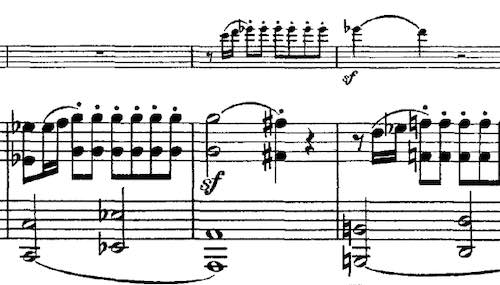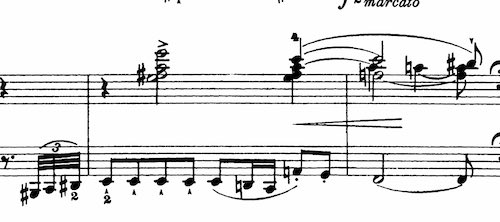Shared motif in Beethoven Spring Sonata and Liszt Sonata
Similarities between Beethoven’s spring Sonata and Liszt’s sonata
In this blog post I would like to share my opinion regarding a similarity between The “Spring” violin Sonata by L.v.Beethoven (Beethoven Sonata No.5 in F major, Op.24) and the infamous Sonata in b minor by Franz Liszt. Sometimes, when working on a wide variety of musical repertoire one tends to notice interesting similarities and parallels between musical pieces. It is interesting to spend a little more time digesting these parallels.
Motif of repeating note
In this Blog post I will only highlight one similar motif, namely the motif of the repeating note. Let’s first have a closer look at the motif.
Beethoven Spring Sonata for Violin and Piano

Repeating note motif and theme in Beethovens Spring Sonata
This repeating note is taking from the Exposition of the “Spring Sonata”, the 5th violin sonata, of Beethoven, from Bar 62. This motif appears for the first time in the violin part in Bar 46, and follows the second theme of the first movement. The second theme can be interpreted to start in Bar 38, which harmonically makes sense, as it starts in the dominant key, C major.
Liszt Sonata in b minor

This repeating motif is found directly in the opening of the Liszt Sonata. It comes back throughout the piece. Whether it functions as a “standalone” theme can be debated, but in my opinion it is in a way comparable to a Wagner-style “Leitmotif”.
See my old analysis of this sonata for more information.
Analysis of motif and its role
Now that I have presented both motifs let’s look at them in a more detailed way. We notice, that on paper these motifs are actually very different: They are written in completely different ways, feature different rhythms and the amount of repeating notes are different. One could almost say, that apart from the fact that one note is repeated 5 or 6 times, everything else is different.
So why did I notice this similarity? With so many classical music pieces existing, this could very well be a mere coincidence. Or could it?
Of course, many things are indeed different, but when analysing the psychological effect of this motif, we start to recognize much more: The dramatic effect of tension is indeed very similar for both motifs (more about that later). Moreover, the “energy” when performing said motif is actually very comparable.
One more very important argument is the presence of diminished chords, surrounding this motif in both pieces of Beethoven and Liszt.
Only when we look at the bigger picture we can start to see a more refined image/analysis emerging (as is often the case in life): In both Sonata’s this motif can be seen as an “antagonist” to the theme of Spring/Love/Harmony (or whatever - it really depends on your interpretation).
A little later I will elaborate more on this.
Is this motif that special?
In essence, the presented motif is a very simple one: The most simple, in fact - it is just a repeating note after all.
There are a great many classical and romantic pieces that come to mind, which feature a very similar motif: It is used very often to show a dramatic effect and affect, especially when viewed in contrast with a different theme or motif, which is totally different.
So strictly speaking, finding this motif can be just a coincidence, and presenting this finding is not in any way special whatsoever. But I still think there is something to it. Let’s have a look at some interpretations with some creative liberty taken by me.
Possible point of views and interpretations

Painting by Anrold Boecklin, fiedelnder Tod (public domain)
In Beethoven’s Spring Sonata this motif can be interpreted as the dramatic antagonist to the Spring Theme (the main theme presented in the beginning). In Liszt’s B minor Sonata this motif can indeed also be interpreted as a dramatic antagonist. If we take the Faust (by Goethe) “interpretation” of the Liszt Sonata, this motif could be very well the motif of Mephisto (basically the devil). See my old analysis of the Liszt sonata for more information about this.
It is important to mention that both works are not programmatic music strictly speaking. But on a deeper psychological level, they can be seen as such (which contrasts with the text-book approach to history of western musical culture).
Again, if we take the “Faust interpretation” of the Liszt Sonata, in the sense that it is about love it is similar to the Spring Sonata. Basically, with Spring a lot of times (especially 200 years ago) what really was meant was love.
In any depiction of love, especially in the romantic ideal, often times something darker is often lurking on the background. Take the same story of Faust as an example, who Mephisto (=the devil) made fall in love with a beautiful girl. However, in all happiness and harmony that falling in love entails, the story of Faust’s love did not end happily, but in fact very sinister (as the devil was involved).
Now, if we look at both composers, both Beethoven and Liszt had experience of falling in love, and also unhappy love. Hence, consciously or subconsciously, this also would have to apply to their own music.
Last but not least, Liszt was very well aware of the works of Beethoven and he admired him very much. This means that Liszt could be aware of Beethoven’s spring sonata, and perhaps also more than “just a musical piece” - it could be the case that Liszt understood the underlying struggles very well. So maybe, very maybe, this motif is not a coincidence after all, but a very concious artistic choice.
P.S.
If you have own ideas about this topic and would like to contribute to this article, feel free to contact me. I will make additions to this post and give you credit for it in return.